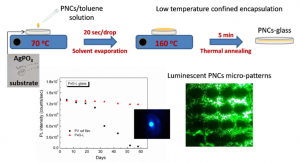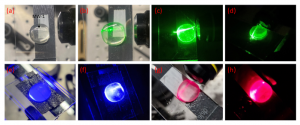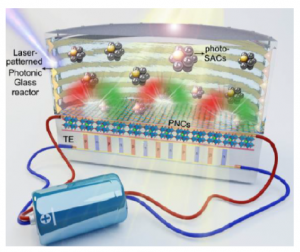Advanced Composite Glasses for Optoelectronics
Objective: This research topic aims at the development of advanced composite glasses for state-of-the-art optoelectronic applications by means of simplified novel fabrication synthesis procedures.
Abstract: Over the years, the importance of inorganic oxide glasses in various fields of optoelectronics, photonics and solid state electrochemical technological applications has been demonstrated. A continuous scientific challenge lies in maximizing the functionality of novel glassy materials upon introducing new features, and thus expanding their potential towards next-generation applications and devices, while simplifying their fabrication routes. Along these lines, this research activity focuses on the development of advanced composite glasses by means of two approaches. First, Dr. I. Konidakis has demonstrated in the ULMNP Laboratory a novel, low-temperature, post-melting encapsulation (PME) synthesis protocol for the incorporation of perovskite nanocrystals (PNCs), 2D materials, and metallic nanoparticles (NPs) within inorganic oxide transparent glasses. The developed PME protocol expands beyond the current state-of-the-art in terms of allowing the controlled and confined positioning of the functional materials within the glass. Such aspect is not possible when conventional melting procedures are followed. Second, we take advantage of ultrafast pulsed and continuous wave (cw) laser processing techniques for the introduction of advanced photonic features within the bulk or on the surface of the developed composite glasses.
Perovskite Glasses (PV-Glasses): In the case of perovskite glasses, we have demonstrated the formation of highly luminescent and ultrastable perovskite patterns within phosphate glasses, upon following the simple low-temperature PME fabrication procedure and cw laser processing. The embedded micro-patterns exhibit remarkable photoluminescence stability while their periodicity can be varied according to the photonic application (Figure 1).

Figure 1: Schematic representation of the controlled incorporation of perovskite nanocrystals (PNCs) within inorganic oxide glass by means of low-temperature, post- melting encapsulation (PME). The photoluminescence stability of the composite glass and the formation of a typical perovskite micro-pattern embedded within glass are also shown.
2D materials Glasses (2D-Glasses): Based on the same PME synthesis approach, we have demonstrated the incorporation of 2D materials within phosphate glasses. This allows significant tailoring of the photoluminescence properties of the composite 2D-Glasses. Namely, robust B-exciton emission at room temperature in few layers of MoS2:Ag nanoheterojunctions was induced upon encapsulating MoS2 layers inside silver metaphosphate glass (Figure 2). The obtained remarkable B-exciton emission is attributed to enhanced exciton-plasmon coupling that takes place in silver nanoparticles-MoS2 nanoheterojunctions. Such findings provide a promising way towards tailoring the emission properties targeting application devices working with B-exciton emissions.

Figure 2: Schematic representations of the incorporated MoS2 flakes inside the transparent AgPO3 glass (left), and the mechanism illustrating the exciton-plasmon coupling (center). Room temperature PL emission of pristine AgPO3 glass, MoS2 on Si substrate, and incorporated MoS2 within AgPO3 glass (right).
Photochromic glasses: Photochromic glasses offer solutions in various types of temperature regulation, irradiation protection, and energy saving challenges that have become of particular importance. In this activity we employ the post-glass melting encapsulation protocol for the development of advanced composite photochromic glasses upon incorporating AgCl crystals within transparent phosphate glasses. The developed glasses exhibit remarkable photochromic features with brief response times that exceed the current state-of-the-art, while ongoing work focuses on maximizing the percentage of photochromic switching at various wavelengths (Figure 3).

Figure 3: UV irradiation of the AgCl-AgPO3 composite glass (left). Optical absorbance before and after various periods following UV irradiation (center), and photochromic switching response versus time (right).
Optical waveguides: In the frame of this activity we have developed a new concept of how to prepare advanced glass waveguides that allow transmission of light in different directions simultaneously, without the need for chemical etching procedures and ultrafast laser processing. The latter methods are the current state-of-the-art (SOA) benchmark. Based on this, it is believed that the PME innovative route will be a game changer in the field of waveguides and photonic circuits development both in lab prototypes and industrial production for two main reasons. First, it simplifies and makes safer the fabrication process without producing liquid toxic wastes, while on the other hand reducing drastically the production cost since the necessity of employing expensive ultrafast laser equipment vanishes. In brief, our novel method relies on the employment of the simple, fast, low-temperature, PME of glass microwires (MWs) within inorganic oxide glasses. The composition of the employed glasses is chosen so that the MWs refractive index is higher than that of the base glass, and thus, forcing the light to travel within the embedded MWs. More importantly, the incorporation of the glass MWs is done with a controlled manner, and allows the creation of distinct pathways within the same waveguide. In such a way, the transmission of light of different colors and in multiple directions is possible within the same waveguide device. Overall, we believe that the proposed method poses important technological advancements and opens the doors for the industrial scale production of glass waveguides and composites glasses for various photonic circuits, optoelectronic, and smart sign applications.

Figure 4: Indicative optical waveguides upon the incorporation of glass microwires (MWs) within glasses by means of the innovative post-melting encapsulation (PME).

The Glas-A-Fuels vision: The novel PME approach of Dr. I. Konidakis resulted in the successful evaluation of the HORIZON-EIC-2023-PATHFINDER-01-01 proposal, Glas-A-Fuels. “Single-Atom Photocatalysts Enhanced by a Self-Powered Photonic Glass Reactor to Produce Advance Biofuels”.
Active projects: Glas-A-Fuels, TheSmartMat.
Contact persons: Dr. Ioannis Konidakis, Dr. Emmanuel Stratakis.
Project members: Dr. Ioannis Konidakis, Mr. Harris Goniotakis, Dr. Emmanuel Stratakis.
Projects members Alumni: Dr. Abdus S. Sarkar, Dr. Efthymis Serpetzoglou, Dr. Konstantinos Tsimvrakidis, Miss Anna Karagiannaki, Mr. Marios Adamidis.
Collaborators: Dr. Ioanna Demeridou, Prof. George Kioseoglou.
Selected publications:
- “Post-glass melting synthesis and photochromic properties of composite AgCl-AgPO3 glasses”, M. Adamidis, I. Konidakis* and E. Stratakis, J. Materiomics 9, 455 (2023).
- “Laser-induced erasable and re-writable waveguides within silver phosphate glasses”, K. Tsimvrakidis, I. Konidakis and E. Stratakis, Materials 15, 2983 (2022).
- “Advanced composite glasses with metallic, perovskite, and two-dimensional nanocrystals for optoelectronic and photonic applications”, I. Konidakis, A. Karagiannaki and E. Stratakis, Nanoscale 14, 2966 (2022).
- “Probing the effect of a glass network on the synthesis and luminescence properties of composite perovskite glasses”. A. Karagiannaki, I. Konidakis, G. Kourmoulakis, I. Demeridou, J. Dzibelova, A. Bakandritsos and E. Stratakis, Opt. Mater. Express 12, 823 (2022).
- “Robust B-exciton emission at room temperature in few-layers of MoS2:Ag nanoheterojunctions embedded into a glass matrix”, A.S. Salam, I. Konidakis, I. Demeridou, E. Serpetzoglou, G. Kioseoglou and E. Stratakis, Sci. Rep. 10, 15697 (2020).
- “Highly luminescent and ultrastable cesium lead bromide perovskite patterns generated in phosphate glass matrices”, I. Konidakis, K. Brintakis, A. Kostopoulou, I. Demeridou, P. Kavatzikidou and E. Stratakis, Nanoscale 12, 13697 (2020).
- “Effect of composition and temperature on the second harmonic generation in silver phosphate glasses”, I. Konidakis, S. Psilodimitrakopoulos, K. Kosma, A. Lemonis and E. Stratakis, Opt. Mater. 75, 796 (2018).
- “Erasable and rewritable laser-induced gratings on silver phosphate glass”, I. Konidakis, E. Skoulas, A. Papadopoulos, E. Serpetzoglou, E. Margariti and E. Stratakis, Appl. Phys. A 124, 839 (2018).

